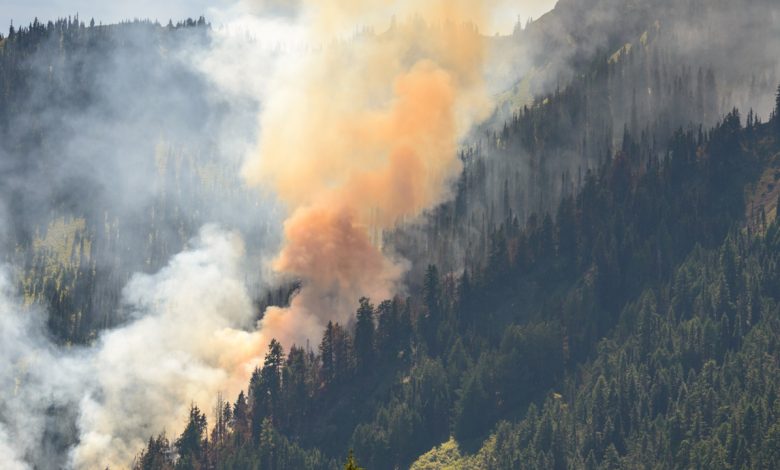Forest fires and their management
(Syllabus-Disaster management ,GS Paper 2)

Context- With summer season nearing its peak, Kerala forest are at a risk again to massive fires some of which are natural and uncontrollable in the districts of Palakkad, Malappuram and others.
What are forest fires?
Forest fires are large scale fire breakouts in forests and grasslands that have adverse impact on the environment and on the local flora and fauna. Forest fires are natural in most cases and also have anthropogenic causes that spread as per the topography ,wind and other environmental factors. They are also known as bush, vegetation or wildlife fires. Forest fires are more common in dry deciduous forest areas than in evergreen ,semi evergreen and montane temperate forests . As per the Indian state of forest report 2019 (ISFR), 36% of the forest cover in India fall in the vulnerable area prone to forest fire with nearly 4 % of forest cover in the country is extremely prone to forest fire and 6% highly prone .
Causes of forest fires are natural and manmade
Natural causes :
- Soaring high temperatures, low rainfall, low humidity
- Dry vegetation ( dry leaves and rubbing tree trunks causing friction) that catch fire in summers.
- Lightening
Manmade causes :
- Careless discarding of cigarette butts and beedis.
- Uncontrolled or prescribed burning practised by local communities and forest officials to reduce inflammable dry leaves and undergrowth.
- Poachers start forest fires to hunt down animals.
- Using of fires to prepare sites for planting.
- Controlling weeds,( invasive species like in case of Kerala’s recent growth of weed ferns (Pteridium aquilinium) pests and improve habitat quality for wildlife
- Preserve plant species dependent on fire for their survival
- Practise by farmers to improve soil fertility and reduce soil acidity.
Impact of forest fires
- Variations in the mineral composition and geochemical transformations that deplete soil health.
- Affects the density and diversity of insects like grasshoppers, amphibians and other reptiles.
- Cause great havoc to the habitat of the wildlife species.
- Cause release of large quantities of carbon dioxide ,carbon monoxide and other fine particulate matter into the atmosphere causing air pollution
- Attempt to clearing weeds with fires has in some cases been a further catalyser of its growth and spread.
Management of forest fires:
The forest survey of India along with state disaster management have chalked several forest fire management plans that operate at various levels .
- Classification of fire prone areas into high ,medium and low risk areas.
- Taking account of quantum of inflammable content i.e. fuel load( dry vegetation, history of forest fires and human activities).
- Operationalization of fire plans at station, range, divisional and circle levels.
- Use of fire breaks or fire lines that are small areas of cleared ditches and counter fires that acts as efficient barrier to reduce the intensity and further spread of fires
- Check on local community activities like during festivals peaking in summer, people setting forests on fire is common.
- Indulging local communities who can act as fire watchers of the fire gangs.
- Use of robust technology to map and detect forest fire , use of GIS, Satellite based remote sensing like MODIS (Moderate Resolution Imaging Spectro-radiometer) and SNPP-VIIRS (Suomi-National Polar-orbiting Partnership – Visible Infrared Imaging Radiometer Suite)
National initiative for forest fire management:
- Forest fire prevention and management scheme- for states to deal with forest fires.
- National action plan for forest fires (NAPFF) 2018- by informing and creating awareness among local communities and incentivizing them for helping in forest fire mitigations.
Way forward
The forests serve as efficient means to mitigate climate change serving as carbon sinks. However their burning has turned them into carbon producers further negatively contributing to climate change. The forest department along with the local communities need to work in tandem to control this serious issue that has multiple and adverse environmental impacts.





.png)



